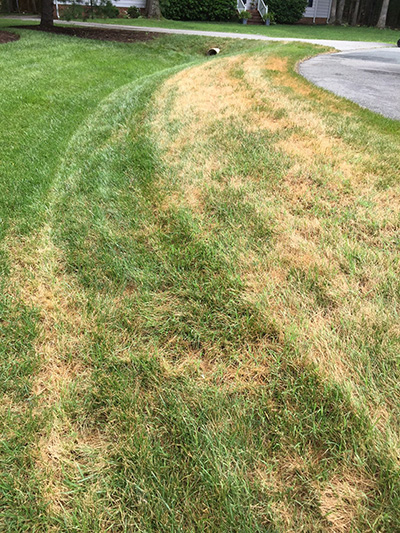Heat Stress
The heat is on and my lawn is showing it – yours probably is too. Here in Central Virginia, we live in a transition zone, which means it gets really cold in the winter and extremely hot in the summer, which can (and usually does) equate to stressed turf. Although we can’t really do anything about Virginia weather, there are some steps we can take to help our grass handle the heat.
The three tips below should help your lawn survive the hot weather.
Water in the morning
The best time to water is between 4 am and 7 am. This is when temperatures are at the coolest and evaporation loss is the lowest. This also allows the lawn ample drying time. Watering in the afternoon is not advised as a high percentage of moisture is lost to evaporation. Watering in the evening or at night will cause disease problems, as high humidity and warm nighttime temperatures are prime contributors to fungus.
Watering ½ to ¾ of an inch, 2-3 times per week, is generally sufficient. In times of excessive drought, higher amounts of water may be needed to keep fescue or bluegrass from going dormant. Do not water every day as this causes turf grass plants to have a shallow root system.

Avoid foot traffic
Walking on your lawn when it is properly hydrated is no problem – the grass springs back with ease. Walking on a dry, heat-stressed lawn, however, can cause damage to the grass blades as they are much less resilient.
Make sure your mower blades are sharp, and leave it set to high
A sharp mower blade makes a clean-cut, while a dull mower blade rips the top of the grass blade and leaves it shredded. In turn, shredded grass blades lose more moisture. The tips of the shredded grass also will turn white or brown, which can cause a dull, frosted look to the lawn.
Mowing the lawn on a high setting at 3.5-4 inches tall helps your grass because the longer the shoot, the deeper the root – and deeper roots help in the search for water. Avoid mowing your lawn during the hottest parts of the day to prevent creating stress on the grass.
Fall weather will be here before we know it and the summer heat will be a memory. Until then these tips can help you and your lawn keep your cool!
